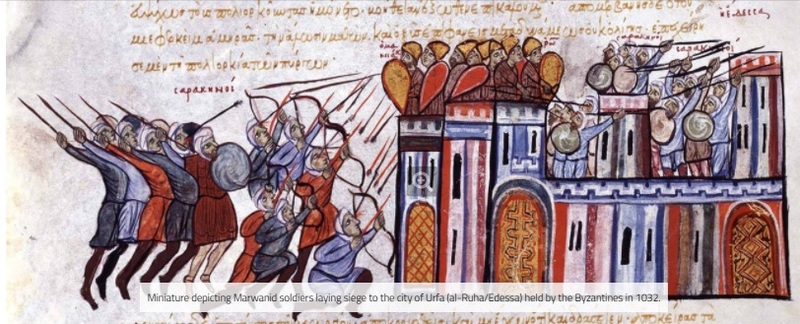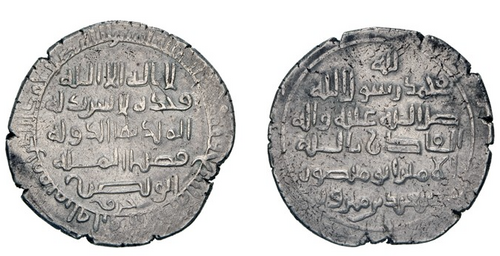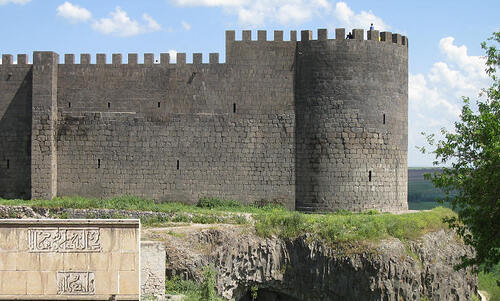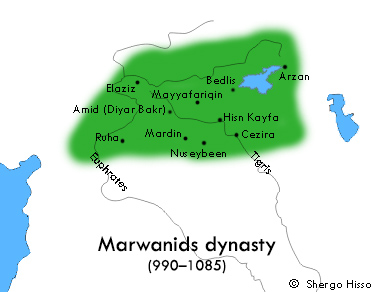From 983 to 1085 AD, a Kurdish power, historically called the Marwans, appeared from the borders of Armenia to Mesopotamia. The founder of this power was a Kurdish tribal chief called "Abu Abdullah Hussein son of Dostak", known as "Bazi Kurd", who, according to Ibn Asir, was born in the Bahasme Mountains near the Hayzan region of Diyarbakir. Baz was an expert, skilled, and generous man from the Kurds of Hamidiya and the chief of the Hamidiya tribe.
"Abu Abdullah Hussein Ibn Dostak" took the weakening of Buyid's power as an opportunity to appear and, despite having some castles, attacked the areas under Buyid and Diyarbakir and then occupied Miafareqin. After capturing Nusaybin and Jazira, he turned south to Mesopotamia. Near Mosul, Baz and "Pana Khasrow Ezaddowla Daylami", the powerful Emir of Buyid, who was in the last years of his rule, met. According to history, the Daylami leader was scared of Baz and attempted to kill him but was not successful. Baz took advantage of the chaos after the death of the famous Emir of Buyid, "Ezuddawla", who captured Mosul and was a threat to Baghdad, the residence of the Abbasid Caliph.

Buyid, who were very afraid, tried again to prevent the victories of Baz, and "Samsamuddawla" Daulami sent an army led by "Bahram son of Ardashir" against the Marwans, but they were defeated. Then Samsamuddawla sent another army led by Abul Qasim Saadi Hajib to fight Baz, but he was unsuccessful too, and could not achieve anything against the Kurdish power.
Abul Qasim Saadi Hajib had captured Mosul, which Baz previously held, but the people of Mosul were dissatisfied and demanded Marwani's rule again, which led to Baz's success in capturing Mosul again.
The successive victories of Abu Abdullah Hussain son of Dostak against Buyid led the Abbasid Caliph to give him the title of "Bazi Kurd". According to history, this was the second time that the Abbasid authority gave the title of "Baz" to its contemporaries. The first time, they gave this title to "Abdurrahman Umavi", who swam passed a river alone, and then, he reached the south of Europe from the north of Africa and established the Umayyad rule of Andalusia.
After the conquest of Mosul, Bazi Kurd was crowned king and minted coins in his name.

Ibn Arzaq, the author of the book "History of Miafareqin", points out that "Baz" was the first Kurdish king. In the third war between Baz and Samsamuddawla, Samsam attacked Baz's property with two armies and encouraged the Hamdani authorities against the Marwans. This time Baz was defeated and retreated to Diyarbakir. Later, Baz asked for peace with Buyid. It was at a time when Buyid was hoping to kill Baz in a conspiracy, but they failed and they forced to acknowledge Baz's power.
Baz's rule was threatened by the Hamdanis, who, with the help of the Arabs of the "Bani Aqeel" tribe, invaded Mosul and claimed it as their inherited property. They also hoped to prevent the Bashnawi Kurds from becoming stronger in Mosul besides taking the power of "Marwanis". In the war among the Marwanis, the Arabs of Bani Aqil, and the Hamdanis, Baz was unsuccessful and was killed by one of the Arabs of Bani Aqil and his body was sent to Baghdad, and there, he was executed. However, because Baz was famous for being a generous and capable person, the people of Baghdad opposed the Arab ruler's actions and offered him funerals and condolences. Then they took off Baz's mutilated body and took it back to Mosul. There he will be buried with respect.
After Baz's death, his nephew Abu Ali Hassan Marwan succeeded him and strengthened his power. He empowered the rule and ruled Marwans for nearly seven years. After him, two other brothers of Abu Ali, Said and Ahmad, also known as Nasruddawla, became the emir of the Marwan dynasty, which lasted about 53 years based on historical documents.

The rule of the Marwanis has been mentioned by most historians of the time, such as Ibn Asir, Abu Shuja'i al-Ruzrawari, who served the Abbasid Caliph "al-Muqtada" as director of the writing department, and Ibn Khaldun. Ibn Khaldun believes that the Marwanis were the only non-Arab rulers on the western borders of the Islamic country at that time.
Nasir Khasrow, the famous Persian poet, passed through Diyarbakir during his famous seven-year journey during the reign of Nasraddwlah and even met the emir. In his travelogue, Nasir Khasrow mentions that the city of Amed under the rule of the Marwans was very different from other cities in Arab, Persian, Indian, and Turkish countries and believes none of those cities are like Amed. Nasir Khasrow also points to the existence of mosques and churches in the city, which at that time, in the turmoil of Islamic and Christian tensions, represented the free and absolute thought of the rule of Nasruddawla Marwani and the Kurds of Amed.

The Marwani rule did not last long after Nasruddawla and the Turks of Ghoz, who later became the founders of the Seljuk rule in Iran and surrounding areas, attacked the areas under Marwani rule and Turks were seen in Diyarbakir for the first time. After decades of war in Diyarbakir and other areas of Marwani rule, eventually succeeded and the Marwan rule collapsed.








